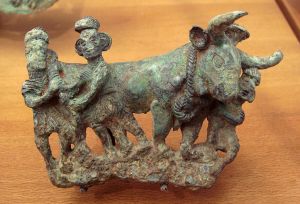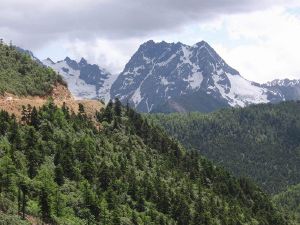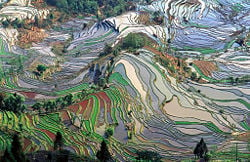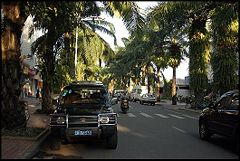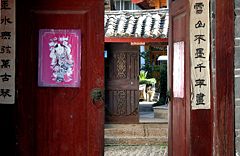Yunnan
- "Yunan" and "If you intended an alternative spelling of the historic Greek cultural region in western Anatolia, see Ionia" redirect here.
| 云南省 Yúnnán Shěng | |
| Abbreviations: 滇 or 云 (Pinyin: Diān or Yún) | |
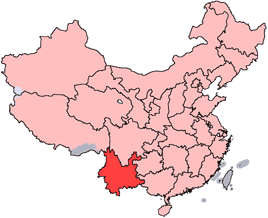
| |
| Origin of name | 云 yún - cloud 南 nán - south "South of the Cloud Mountains" |
| Administration type | Province |
| Capital (and largest city) |
Kunming |
| CPC Ctte Secretary | Bai Enpei |
| Governor | Qin Guangrong |
| Area | 394,100 km² (8th) |
| Population (2004) - Density |
44,150,000 (12th) 112/km² (24th) |
| GDP (2006) - per capita |
CNY 400.2 billion (23rd) CNY 8,961 (29th) |
| HDI (2005) | 0.657 (medium) (29th) |
| Major nationalities | Han - 67% Yi - 11% Bai - 3.6% Hani - 3.4% Zhuang - 2.7% Dai - 2.7% Miao - 2.5% Hui - 1.5% |
| Prefecture-level | 16 divisions |
| County-level | 129 divisions |
| Township-level† | 1565 divisions |
| ISO 3166-2 | CN-53 |
| Official website http://www.yn.gov.cn (Simplified Chinese) | |
| Source for population and GDP data: 《中国统计年鉴—2005》 China Statistical Yearbook 2005 Source for nationalities data:ISBN 7503747382 《2000年人口普查中国民族人口资料》 Tabulation on nationalities of 2000 population census of China † As at December 31, 2004
ISBN 7105054255 | |
Yunnan ▶ (Simplified Chinese: 云南; Traditional Chinese: 雲南; pinyin: Yúnnán; literally "south of the clouds") is a province of the People's Republic of China, located in the far southwestern corner of the country. The capital of the province is Kunming.
Emblem
Camellia reticulata, a plant native to Yunnan Province, is the emblem of this province.
History
The Yuanmou Man, a Homo erectus fossil unearthed by railway engineers in the 1960s, has been determined to be the oldest known hominid fossil in China. By the Neolithic period, there were human settlements in the area of Lake Dian. These people used stone tools and constructed simple wooden structures.
Around the third century B.C.E., the central area of Yunnan around present day Kunming was known as Dian. The Chu general Zhuang Qiao (庄跤) entered the region from the upper Yangtze River and set himself up as "King of Dian". He and his followers brought into Yunnan an influx of Chinese influence, the start of a long history of migration and cultural expansion.
In 221 B.C.E., Qin Shi Huang unified China and extended his authority south. Commanderies and counties were established in Yunnan. An existing road in Sichuan – the "Five Foot Way" – was extended south to around present day Qujing (曲靖), in eastern Yunnan. In 109 B.C.E., Emperor Wu sent General Guo Chang (郭昌) south to Yunnan, establishing Yizhou commandery and twenty-four subordinate counties. The commandery seat was at Dianchi county (present day Jinning 晋宁). Another county was called "Yunnan", probably the first use of the name. To expand the burgeoning trade with Burma and India, Emperor Wu also sent Tang Meng (唐蒙) to maintain and expand the Five Foot Way, renaming it "Southwest Barbarian Way" (西南夷道). By this time, agricultural technology in Yunnan had markedly improved. The local people used bronze tools, plows and kept a variety of livestock, including cattle, horses, sheep, goats, pigs and dogs. Anthropologists have determined that these people were related to the people now known as the Tai. They lived in tribal congregations, sometimes led by exile Chinese.
In the Records of the Grand Historian, Zhang Qian (d. 113 B.C.E.) and Sima Qian (145-90 B.C.E.) make references to "Shendu", which may have been referring to the Indus Valley (the Sindh province in modern Pakistan), originally known as "Sindhu" in Sanskrit. When Yunnan was annexed by the Han Dynasty, Chinese authorities reported an Indian "Shendu" community living there.[1]
During the Three Kingdoms, the territory of present day Yunnan, western Guizhou and southern Sichuan was collectively called Nanzhong. The disollution of Chinese central authority led to increased autonomy for Yunnan and more power for the local tribal structures. In AD 225, the famed statesman Zhuge Liang led three columns into Yunnan to pacify the tribes. His seven captures of Meng Huo, a local magnate, is much celebrated in Chinese folklore.
In the fourth century, northern China was largely overrun by nomadic tribes from the north. In the 320s, the Cuan (爨) clan migrated into Yunnan. Cuan Chen (爨琛) named himself king and held authority from Lake Dian (then called Kunchuan [昆川]). Henceforth the Cuan clan ruled Yunnan for over four hundred years. In 738, the kingdom of Nanzhao was established in Yunnan by Piluoge (皮罗阁), who was confirmed by the imperial court of the Tang Dynasty as king of Yunnan. Ruling from Dali, the thirteen kings of Nanzhao ruled over more than two centuries and played a part in the dynamic relationship between China and Tibet. In 937, Duan Siping (段思平) overthrew the Nanzhao and established the Kingdom of Dali. The kingdom was conquered by the Mongol and Chinese armies of Kublai Khan.
In 1894, George Ernest Morrison, an Australian correspondent for The Times, travelled from Beijing to British-occupied Burma via Yunnan. His book, An Australian in China, details his experiences.
From 1916 to 1917, Roy Chapman Andrews and Yvette Borup Andrews led the Asiatic Zoological Expedition of the American Museum of Natural History through much of western and southern Yunnan, as well as other provinces of China. The book, Camps and Trails in China, records their experiences.
Geography
Yunnan is the most southwestern province in China, with the Tropic of Cancer running through its southern part. The province has an area of 394,000 square km, 4.1% of the nation's total. The northern part of the province forms part of the Yunnan-Guizhou Plateau. The province borders Guangxi Zhuang Autonomous Region and Guizhou Province in the east, Sichuan Province in the north, and Tibet Autonomous Region in the northwest. It shares a border of 4,060 km with Myanmar in the west, Laos in the south, and Vietnam in the southeast.
Borders
Bordering provinces are Tibet, Sichuan, Guizhou and Guangxi. Bordering countries are Vietnam (the main border crossing by road and rail is at Hekou-Lao Cai, the only land border crossing open to non-Chinese/non-Vietnamese), Laos (at Boten) and Myanmar (with the main border crossing at Ruili, the only land border open to non-Chinese/non-Burmese).
Elevation
The highest point in the north is the Kawagebo Peak in Deqin County on the Diqing Plateau, which is about 6,740 meters high; and the lowest is in the Honghe River Valley in Hekou County, with an elevation of 76.4 meters.
Rivers
The province is drained by six major river systems:
- Yangtze, here known as the Jinsha Jiang (River of Golden Sands), drains the province's north.
- Pearl River, with its source near Qujing, collects the waters from the east.
- the Mekong (Lancang), which flows from Tibet into the South China Sea forming the boundaries between Laos and Myanmar, between Laos and Thailand, through Cambodia and Vietnam
- the Red River (Yuan) has its source in the mountains south of Dali and enters the South China Sea through Hanoi, Vietnam
- Salween, which flows into the Gulf of Martaban and the Andaman Sea through Myanmar
- the Irrawaddy has a few small tributaries in Yunnan's far west, such as the Dulongjiang, and rivers in the prefecture of Dehong.
Administrative divisions
Natural resources
Yunan not only has more plant species of tropical, subtropical, temperate, and frozen zones than any other province in the country, but also has many ancient, endemic plants, as well as species introduced from foreign countries. Among the 30,000 species of plants in China, 18,000 can be found in Yunnan. Yunnan is also home to a variety of animal species, most notably the southeast Asian gaur, a giant forest-dwelling ox, the tiger, and the Asian elephant.
More than 150 kinds of minerals have been discovered in the province. The potential value of the proven deposits in Yunnan is 3 trillion yuan, 40 % of which come from fuel minerals, 7.3 % from metallic minerals, and 52.7 % from nonmetallic minerals.
Yunnan has proved deposits of 86 kinds of minerals in 2,700 places. Some 13% of the proved deposits of minerals are the largest of their kind in China, and two-thirds of the deposits are among the largest of their kind in the Yangtze River valley and in south China. Yunnan ranks first in the country in deposits of zinc, lead, tin, cadmium, indium, thallium, and crocidolite.
Yunnan has sufficient rainfall and many rivers and lakes. The annual water flow originating in the province is 200 cubic kilometers, three times that of the Yellow River. The rivers flowing into the province from outside add 160 cubic kilometers, which means there are more than ten thousand cubic meters of water for each person in the province. This is four times the average in the country. The rich water resources offer abundant hydro-energy.
Demographics
- Total population
- 43.33 million (2002)
- Population growth rate
- 10.6
- Average life expectancy
- 65.1 years (male), 67.7 years (female) (1995)
Ethnicity
Yunnan is noted for a very high level of ethnic diversity. It has the highest number of ethnic groups among all provinces and autonomous regions in China. Among the country's fifty-six recognised ethnic groups, twenty-five are found in Yunnan. Some 38% of the province's population are members of minorities, including the Yi, Bai, Hani, Tai, Dai, Miao, Lisu, Hui, Lahu, Va, Nakhi, Yao, Tibetan, Jingpo, Blang, Pumi, Nu, Achang, Jinuo, Mongolian, Derung, Manchu, Shui, and Buyei. Several other groups are represented, but they live neither in compact settlements nor do they reach the required threshold of five thousand to be awarded the official status of being present in the province. Some groups, such as the Mosuo, who are officially recognised as part of the Naxi, have in the past claimed official status as a national minority, and are now recognised with the status of Mosuo people.
Ethnic groups are widely distributed in the province. Some twenty-five minorities live in compact communities, each of which has a population of more than five thousand. Ten ethnic minorities living in border areas and river valleys include the Hui, Manchu (the Manchu, remnants of the Qing administration, do not live in compact settlements and are in all respects indistinguishable from the Han), Bai, Naxi, Mongolian, Zhuang, Dai, Achang, Buyei and Shui, with a combined population of 4.5 million; those in low mountainous areas are the Hani, Yao, Lahu, Va, Jingpo, Blang and Jino, with a combined population of 5 million; and those in high mountainous areas are Miao, Lisu, Tibetan, Pumi and Drung, with a total population of four million.
An oft-repeated proverb tells the story of three brothers who were born speaking different languages: Tibetan, Naxi, and Bai. Each settled in different areas of Yunnan and Tibet, respectively, the high area, the middle area, and the low area.
Languages
Most dialects of the Chinese language spoken in Yunnan belong to the southwestern subdivision of the Mandarin group, and are therefore very similar to the dialects of neighbouring Sichuan and Guizhou provinces. Notable features found in many Yunnan dialects include the partial or complete loss of distinction between finals /n/ and /ŋ/, as well as the lack of /y/. In addition to the local dialects, most people also speak Standard Chinese (Putonghua, commonly called "Mandarin"), which is used in the media, by the government, and as the language of instruction in education.
Yunnan's ethnic diversity is reflected in its linguistic diversity. Languages spoken in Yunnan include Tibeto-Burman languages such as Bai, Yi, Tibetan, Hani, Jingpo, Lisu, Lahu, Naxi; Tai languages like Zhuang, Bouyei, Dong, Shui, Tai Lü and Tai Nüa or northern lao dialect; as well as Hmong-Mien languages.
The Naxi, in particular, use the Dongba script, which is the only ideographic writing system in use in the world today. The Dongba script was mainly used to provide the Dongba priests with instructions on how to carry out their rituals: today the Dongba script features more as a tourist attraction. The most famous western Dongba scholar was Joseph Rock.
Literacy
By the end of 1998, among the province's population, 419,800 had received college education or above, 2.11 million, senior middle school education, 8.3 million, junior middle school education, 18.25 million, primary school education, and 8.25 million aged 15 or above, illiterate or semi-literate.
Economy
Yunnan is one of China's relatively undeveloped provinces with more poverty-stricken counties than the other provinces. In 1994, about 7 million people lived below the poverty line of less than an annual average income of 300 yuan per capita. They were distributed in the province's 73 counties mainly and financially supported by the central government. With an input of 3.15 billion yuan in 2002, the absolutely poor rural population in the province has been reduced from 4.05 million in 2000 to 2.86 million. The poverty alleviation plan includes five large projects aimed at improving infrastructure facilities. They involve soil improvement, water conservation, electric power, roads, and "green belt" building. Upon the completion of the projects, the province will solve the problem of shortages of grain, water, electric power and roads and improve ecological conditions.
Yunnan's four pillar industries include tobacco, biology, mining, and tourism. Yunnan has trade contacts with more than seventy countries and regions in the world. Yunnan will also establish the Muse border trade zone (located in Ruili) along its border with Myanmar [1]. Yunnan mainly exports tobacco, machinery and electrical equipment, chemical and agricultural products, and non-ferrous metals. In 2002, its total two-way trade (imports and exports) reached US$2.23 billion. In 2002, the province signed foreign direct investment contracts involving US$333 million, of which US$112 million were actually utilized during the year. Yunnan's unemployment rate in 2002 was 4%.
Yunnan's nominal GDP in 2006 was 400.2 billion yuan (US$51.7 billion), an annual growth rate of 11.9%. Its per capita GDP was 8,961 yuan (US$1,160). The share of GDP of Yunnan's primary, secondary, and tertiary industries were 21.1%, 42.8%, and 36.1% respectively.
Education
Universities and Colleges
- Kunming University of Science and Technology
- Yunnan University
- Yunnan University of Finance and Economics
- Yunnan Agricultural University
- Yunnan Normal University
Transportation
Railways
Yunnan was first connected by railway not to the rest of China, but to the port of Haiphong by a French engineered narrow gauge railway completed in 1910. It took another fifty years for the province to be connected by rail to the rest of China with the completion of the Chengdu-Kunming line. Later a line connecting Kunming to Guiyang followed. Two further lines have been added recently: a southern line connecting to Nanning and a north-eastern line connecting to Sichuan.
An extension now also links Kunming to Dali, with the stretch to [[Lijiang[[ nearing completion. Plans are underway on extending the old line to Vietnam, while a new and very ambitious plan to link from Dali to Ruili has been announced in 2006. Another plan to extend the railway line from Kunming all the way to Singapore, with connections to the other South East Asian countries, will be opened in 2017.
Highways
Road construction in Yunnan continues unabated: over the last years the province has added more new roads than any other province. Today expressways link Kunming through Dali to Baoshan, Kunming to Mojiang (on the way to Jinghong), Kunming to Qujing, Kunming to Shilin (Stone Forest). The official plan is to connect all major towns and neighbouring capitals with expressways by 2010, and to complete a high-speed road network by 2020.
All county towns are now accessible by paved, all-weather roads from Kunming, all townships have a road connection (the last to be connected was Yangla, in the far north, but Dulongjiang remains cut off for about six months every year), and about half of all villages have road access.
Second-level national highways stretch 958 km, third-level highways, 7,571 km and fourth-level highways, 52,248 km. The province has formed a network of communication lines radiating from Kunming to Sichuan and Guizhou provinces and Guangxi and Tibet autonomous regions, and further on to Myanmar, Laos, Vietnam and Thailand.
Waterways
Generally, rivers are obstacles to transport in Yunnan. Only very small parts of Yunnan's river systems are navigable.
In 1995, the province put an investment of 171 million yuan to add another 807 km of navigation lines. It built two wharfs with an annual handling capacity of 300,000 to 400,000 tons each and four wharfs with an annual handling capacity of 100,000 tons each. The annual volume of goods transported was two million tons and that of passengers transported, two million.
Airports
The province has twenty domestic air routes from Kunming to Beijing, Shanghai, Guangzhou, Chengdu, Haikou, Chongqing, Shenyang, Harbin, Wuhan, Xi'an, Lanzhou, Hangzhou, Xiamen, Nanning, Shenzhen, Guiyang, Changsha, Guilin, Lhasa and Hong Kong; eight provincial air routes from Kunming to Jinghong, Mangshi, Lijiang, Dali, Zhongdian (Shangri-la), Zhaotong, Baoshan and Simao; and nine international air routes from Kunming to Bangkok, Chiang Mai, Yangon, Singapore, Seoul, Hanoi, Ho Chi Minh City, Kuala Lumpur and Vientiane.
The Wujiaba Airport in Kunming is a national first-class airport and the other airports are second-class terminals. A new airport for Kunming, build east of the city, at Dabanqiao began construction in 2006, but is not expected to be completed until 2015.
Culture
One of Yunnan's famous products is Pu-erh tea, named after the old tea trading town of Pu-erh, as well as the Yunnan Golden Needle tea.
Tourism
Tourist centres in Yunnan include:
- Dali, the historic center of the Nanzhao and Dali kingdoms.
- Jinghong, the center and prefectural capital of the Xishuangbanna Dai minority autonomous prefecture.
- Lijiang, a Naxi minority city. It has been a UNESCO World Heritage Site since 1997.
- Shangri-La County (formerly Zhongdian), an ethnic Tibetan township and county set high in Yunnan's north-western mountains.
- The Stone Forest, a series of karst outcrops east of Kunming.
- Yuanyang, a Hani minority settlement with vast rice-terraces.
Sporting teams
Professional sporting teams in Yunnan include:
- Chinese Basketball Association
- Yunnan Bulls
See also
ReferencesISBN links support NWE through referral fees
- ↑ Tan Chung (1998). A Sino-Indian Perspective for India-China Understanding.
External links
- Yunnan Provincial Government
- YunnanExplorer A travel/historical information site with an interactive map of Yunnan
- Yunnan information for expats
- Traveller web site with a lot of photos & tips
- iGuide, a travel site with information about cities, towns, attractions, history and culture.
- Yunnan Travel Guide and Photo Gallery
- English-language expat website with info and news from around Yunnan
- Large map of Yunnan
| Province-level divisions administered by the People's Republic of China (PRC) | |
|---|---|
| Provinces | Anhui · Fujian · Gansu · Guangdong · Guizhou · Hainan · Hebei · Heilongjiang · Henan · Hubei · Hunan · Jiangsu · Jiangxi · Jilin · Liaoning · Qinghai · Shaanxi · Shandong · Shanxi · Sichuan · Taiwan · Yunnan · Zhejiang |
| Autonomous regions | Guangxi · Inner Mongolia · Ningxia · Tibet (Xizang) · Xinjiang |
| Municipalities | Beijing · Chongqing · Shanghai · Tianjin |
| Special administrative regions | Hong Kong · Macau |
| Prefecture-level divisions of Yunnan | |
|---|---|
| Prefecture-level cities: | Baoshan | Kunming | Lijiang | Lincang | Pu'er | Qujing | Yuxi | Zhaotong |
| Autonomous prefectures: | Chuxiong | Dali | Dehong | Dêqên | Honghe | Nujiang | Wenshan | Xishuangbanna |
| List of Yunnan County-level divisions | |
| |||||||||||
Credits
New World Encyclopedia writers and editors rewrote and completed the Wikipedia article in accordance with New World Encyclopedia standards. This article abides by terms of the Creative Commons CC-by-sa 3.0 License (CC-by-sa), which may be used and disseminated with proper attribution. Credit is due under the terms of this license that can reference both the New World Encyclopedia contributors and the selfless volunteer contributors of the Wikimedia Foundation. To cite this article click here for a list of acceptable citing formats.The history of earlier contributions by wikipedians is accessible to researchers here:
The history of this article since it was imported to New World Encyclopedia:
Note: Some restrictions may apply to use of individual images which are separately licensed.
